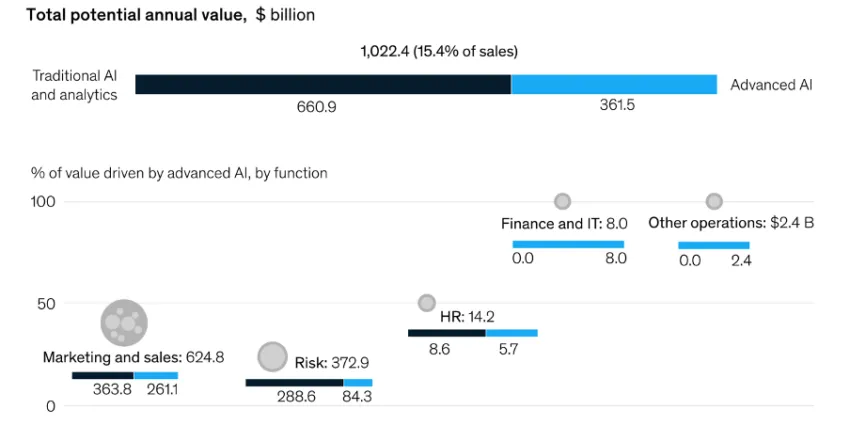
Artificial Intelligence in Banking: Can It Prevent the Next Financial Crisis?
Adopting artificial intelligence (AI) solutions in banking has become more mainstream in recent years. Banking institutions use AI to improve efficiency, enhance customer experiences, and stay competitive in a rapidly changing industry.
The use of AI solutions in banking has become more mainstream in recent years. Banks and financial institutions have been incorporating AI technology to improve efficiency, enhance customer experiences, and stay competitive in a fast-changing industry. What are the reasons for this trend, the benefits of AI adoption, and some examples of AI solutions in banking?
AI in Banking: Reasons for Adoption
One of the rationales for adopting AI in banking is the vast amount of data generated in the industry. Banks handle enormous amounts of data daily, from customer transaction data to market trends and regulatory requirements. AI can help banks analyze and process this data more efficiently, enabling them to make better decisions and boost their services. By using AI solutions, banks can also slash operational costs, as many manual processes can be automated, freeing up staff time for more complex tasks.
Another reason for adopting AI in banking is the growing demand for personalized services from customers. AI solutions can help banks analyze customer data and offer personalized services and recommendations based on their needs and preferences. This can improve the overall customer experience and increase customer loyalty. Adopting AI solutions in banking can benefit both banks and customers. Here are some of the main benefits:
- Improved efficiency: AI solutions can automate many manual processes, such as data entry and analysis, enabling banks to process large amounts of data more quickly and accurately.
- Enhanced customer experience: AI solutions can analyze customer data and provide personalized services and recommendations, improving the overall customer experience.
- Better risk management: AI solutions can help banks identify and analyze risks in real time, enabling them to respond quickly and effectively.
- Increased security: AI solutions can help banks detect and prevent fraud and other security threats, improving the safety of customer data and transactions.
Practical Examples of AI Solutions in Banking
Chatbots: Chatbots are a popular AI solution being used in banking. They can provide customers with instant support and quickly and efficiently answer their queries. Chatbots can also help customers with basic banking tasks, such as transferring money or checking account balances.
Fraud detection: AI solutions can help banks detect and prevent fraud in real time. For example, banks can use AI algorithms to analyze transaction data and identify suspicious activity, such as unusual transactions or spending patterns.
Predictive analytics: Predictive analytics is another AI solution being used in banking. It can help banks analyze customer data and predict their behavior, enabling them to offer personalized services and recommendations.
Loan underwriting: AI solutions can help banks automate the loan underwriting process, enabling them to process loan applications more quickly and accurately. This can reduce the time and cost of processing loan applications and improve the overall customer experience.
These are just some of the instances showing AI’s potential. Most banking institutions implemented the technology in business domains like risk management (56%) and revenue generation through new products and processes (52%).

Per a McKinsey 2020 report, “the potential for value creation is one of the largest across industries, as AI can potentially unlock $1 trillion of incremental value for banks, annually.”
Can AI Help During Banking Crisis
The ongoing banking crisis has created havoc in the financial sector. In the United States, multiple banks have come under fire. The list includes Silvergate, Silicon Valley Bank, Signature Bank, and First Republic Bank. In fact, more than 2,315 banks are currently sitting on assets worth less than their liabilities. Thus, requiring government or private market intervention. But the crisis has not been limited to the US.
There have been many banking crises throughout history. Some of the most notorious examples are the Great Depression of the 1930s, the savings and loan crisis in the United States in the 1980s and 1990s, and the global financial crisis of 2008. Banking crises can occur due to various factors, including excessive risk-taking by financial institutions, inadequate regulation, economic downturns, and external shocks such as natural disasters or geopolitical events.
AI has the potential to play a role in averting the next financial or banking crisis by detecting risks early, improving decision-making, and enhancing regulatory compliance.
Some Uses of AI
AI can analyze vast amounts of data from various sources, including financial statements, market trends, and news reports. By identifying patterns and anomalies, AI algorithms can detect potential risks and alert financial institutions to take appropriate action. Additionally , it can spot fraudulent transactions by analyzing historical data and detecting patterns inconsistent with normal behavior. This can help financial institutions detect and prevent fraudulent actions that could lead to financial losses.
AI can also help analyze credit risk by considering many factors, including historical data, market trends, and external factors, such as geopolitical risks. This can help banks and other financial institutions make more informed lending decisions, reducing the risk of loan defaults. Also, it can monitor regulatory compliance by analyzing vast amounts of data from various sources, including financial statements, customer records, and transactional data. This can help financial institutions identify compliance issues and take action before they become more serious problems.
Lastly, AI can analyze market trends and identify potential risks or opportunities. By providing real-time market insights, AI can help financial institutions make more informed investment decisions and curb the risk of market volatility. By analyzing massive volumes of data in real-time and giving decision-makers valuable insights, AI can assist in developing early warning systems that can spot possible problems in financial markets.
What Do Experts Think?
Experts still need to be convinced despite showcasing use cases and the potential to prevent such instances. For instance, Cathie Wood, the founder of ARK Invest, spoke in a podcast discussing the topic.
Herein, Wood asserted:
“AI is unlikely to fix the banking crisis, but the crisis – which is not over – is another sign that the Fed has gone too far. Many investors ask why we are optimistic. In our view, the equity and fixed income markets are discounting lower interest rates, a + for innovation!”
Other renowned tech leaders, such as Elon Musk, agree with Wood’s narrative about AI. Another software developer in the AI domain opined, “AI might not solve the banking crisis, but it’s an invaluable tool. The Fed’s aggressive rate hikes have consequences, but optimism prevails as markets anticipate rate adjustments. Lower interest rates could foster innovation, bolstering the economy.”
LeackStat 2023
